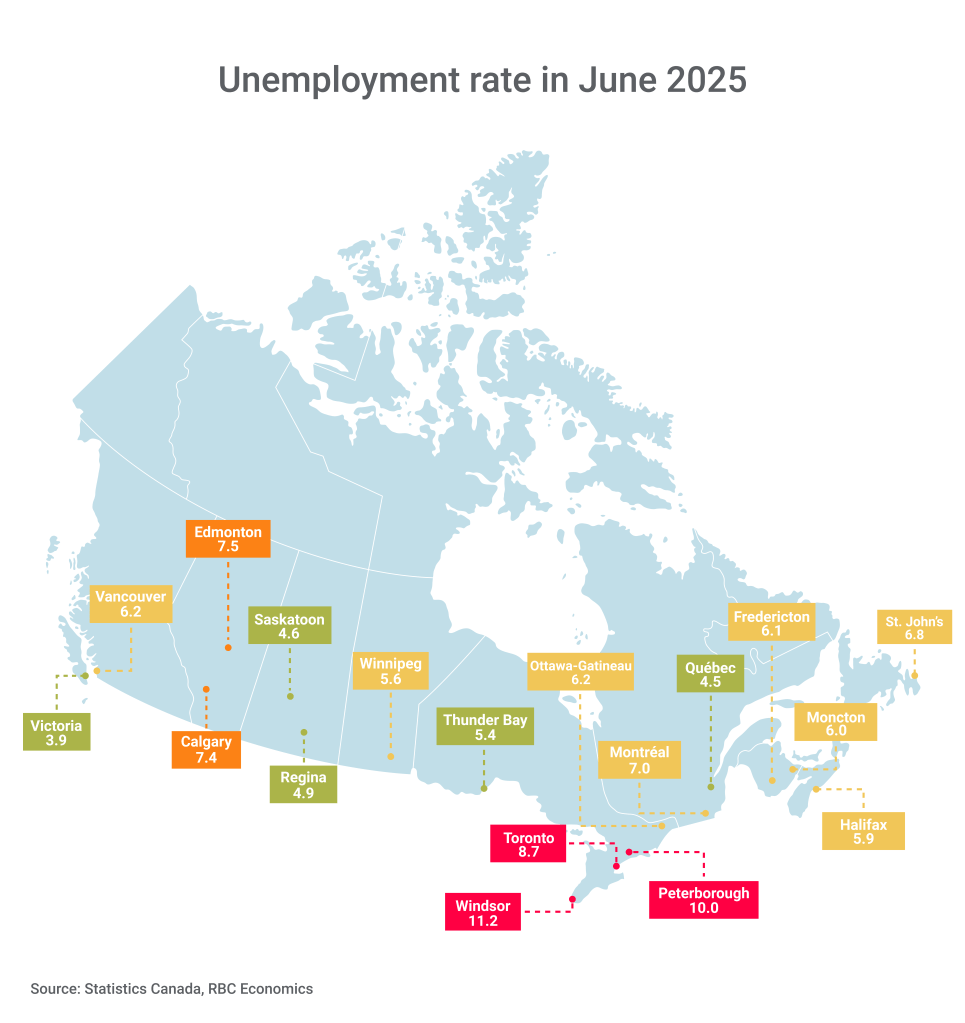Recent trade tensions have amplified existing vulnerabilities in Canada’s labour market. After briefly stabilizing in late 2024 and early 2025, the unemployment rate is climbing again while job vacancies continue to decline, according to a report by Rachel Battaglia, an economist at RBC.

Rachel Battaglia
“June showed slight improvement from May, but we haven’t likely reached a peak in the unemployment cycle,” she said.
“This softness, however, is hardly an emerging trend. The unemployment rate has been on the rise for the better part of three years, following a post-pandemic recovery that drove the jobless rate down to a 53-year low—triggering robust wage growth as employers competed for workers.
“Slack has been building in Canada’s labour market for years. But, the underlying dynamics in Canada’s labour market have evolved significantly. In the wake of the pandemic, rising unemployment primarily reflected the slow absorption of new entrants into the workforce—particularly recent graduates and newcomers—who struggled to find work.
“Now, permanent layoffs are not significantly higher than a year ago, but workers are taking longer to find jobs, and there are clearer signs of job losses in sectors vulnerable to cross-border trade. That’s created fault lines across specific regions and demographics. New labour market entrants are also keeping upward pressure on the unemployment rate despite significant deceleration in Canada’s population growth.”
Battaglia said tariff anxiety has dampened hiring intentions throughout the economy, but actual job losses remain largely concentrated in trade-related sectors. Manufacturing, primary resources, transportation and warehousing, and certain services outside of public administration1 have borne the brunt of recent employment declines.
“Uncertainty surrounding U.S. trade policy appears to be driving much of the weakness, but other factors—like fluctuating commodity prices and a slowdown in homebuilding—are likely intensifying these challenges,” she said.
“Ontario—the heart of Canada’s manufacturing workforce—is where most of the labour market slack has built up, accounting for more than 60% of the unemployment rate increase since 12 months ago.
“Weakness has been especially acute in the southwestern region where most of the province’s manufacturing production takes place. In fact, four of the five highest unemployment rates of any Canadian census metropolitan area were in Ontario including Windsor (11.2%), Peterborough (10%), Oshawa (9.3%) and Toronto (8.7%). Together, these jurisdictions account for nearly a quarter (22%) of Canada’s manufacturing workforce—which shed nearly 45,000 jobs since January (seasonally adjusted)—making it the largest employment decline in any sector this year.”

“Quebec and British Columbia are also contributing to the national unemployment rate increase with Quebec’s substantial manufacturing workforce (30% of Canada’s total) facing similar trade-related pressures. Unlike Canada’s largest provinces, B.C.’s rising unemployment rate appears to be stemming from other cyclical factors—like the completion of major infrastructure projects—rather than slowing export activity. Despite these increases, the jobless rate for these provinces is among the lowest in Canada.
“In contrast, Atlantic Canada shows remarkable resilience. Nova Scotia and New Brunswick have seen unemployment rates fall below the national average in Q2—a rare occurrence given the industry and demographic composition of these provinces.
“Similarly, parts of the Prairies are showing strength with Saskatchewan now boasting Canada’s lowest unemployment rate (4.9%) after seeing steady declines since late 2024. Pockets of Alberta—including Red Deer and Lethbridge—are also seeing labour markets strengthen.”

Mario Toneguzzi
Mario Toneguzzi is Managing Editor of Canada’s Entrepreneur. He has more than 40 years of experience as a daily newspaper writer, columnist, and editor. He was named in 2021 and 2024 as one of the top business journalists in the world by PR News. He was also named by RETHINK to its global list of Top Retail Experts 2024 and 2025.
About Us
Canada’s Entrepreneur is the number one community media platform in Canada for entrepreneurs and business owners. Established in 2016, our podcast team has interviewed over 800 Canadian entrepreneurs from coast-to-coast. With hosts in each province, entrepreneurs have a local and national format to tell their stories, talk about their journey and provide inspiration for anyone starting their entrepreneurial journey and well- established founders.
The commitment to a grass roots approach has built a loyal audience on all our social channels and YouTube – 500,000+ lifetime YouTube views, 250,000 + audio downloads, 50,000 + average monthly social impressions, 15,000 + engaged social followers and 120,000 newsletter subscribers. Canada’s Entrepreneur is proud to provide a local, national and international presence for Canadian entrepreneurs to build their brand and tell their story





